
Astacidea is an infraorder of decapod crustaceans including lobsters, crayfish, and their close relatives.

Gnathosaurus is a genus of ctenochasmatid pterosaur containing two species: G. subulatus, named in 1833 from the Solnhofen Limestone of Germany, and G. macrurus, known from the Purbeck Limestone of the UK. Its fossil remains dated back to the Late Jurassic period.

Trachyteuthis is a genus of extinct octopodiform cephalopods, comprising six species: T. hastiformis, T. latipinnis, T. nusplingensis, T. teudopsiformis, T. covacevichi and T. chilensis.

Acanthochirana is an extinct genus of prawn that existed during the upper Jurassic period. It was named by E. Strand in 1928, and its type species is Acanthochirana cordata. They are distinguished from the related genus Aeger by the presence of teeth on the rostrum, which are absent in Aeger.

Albertoppelia is an extinct genus of prawn which existed during the Late Jurassic period, named after Albert Oppel. It contains the single species Abertoppelia kuempeli. Fossils of Albertoppelia were recovered from the Eichstätt Formation in Bavaria, Germany.
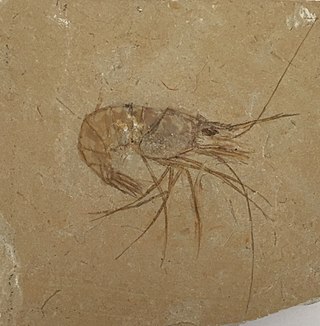
Carpopenaeus is an extinct genus of prawn, which existed during the Upper Jurassic and Cretaceous periods. It contains three species.
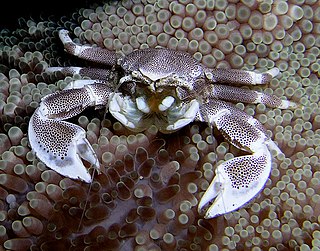
The Galatheoidea are a superfamily of decapod crustaceans comprising the porcelain crabs and some squat lobsters. Squat lobsters within the three families of the superfamily Chirostyloidea are not closely related to the squat lobsters within the Galatheoidea. The fossil record of the superfamily extends back to the Middle Jurassic genus Palaeomunidopsis.
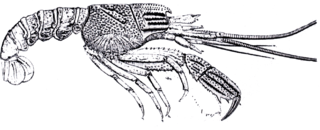
Glyphea is a genus of fossil glypheoid crustaceans that lived from the Jurassic to the Eocene. It includes the following species:

Cancrinos is a genus of fossil crustaceans closely allied with the slipper lobsters. One species is known, C. claviger from the Jurassic of southern Germany.

Hoploparia is a genus of fossil lobster belonging to the family Nephropidae. The type species of this genus is Hoploparia longimana.
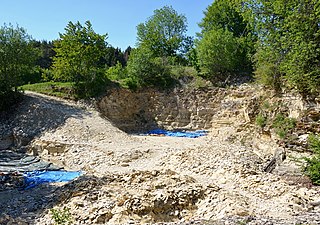
The Nusplingen Limestone is a geological formation in Baden-Württemberg, Germany. It preserves fossils dating to the Kimmeridgian age of the Late Jurassic. It mainly consists of lithographic limestones deposited in a marine basin, similar to the Solnhofen Limestone. Fossils of pterosaurs, thalattosuchians, and the oldest geophilomorph centipede Eogeophilus were found in the Nusplingen Limestone.
Paracancrinos is a prehistoric genus of crustacean that lived during the Upper Cretaceous in what is now Lebanon. It contains a single species, P. libanensis, which was originally described as a species of Cancrinos in 2006, but was moved to its own genus in 2016.
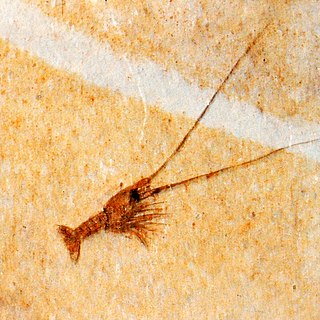
Palinurina is an extinct genus of crustaceans, belonging to the decapods. These animals lived between the Lower Jurassic and the Upper Jurassic and their fossils can be found in Europe. This crustacean is considered one of the oldest lobsters.

Sculda is an extinct genus of mantis shrimp known from the late Jurassic to late Cretaceous of Germany and Lebanon. Although several species have been assigned to it, some are now deemed dubious or moved to different genera. It was a moderate-sized crustacean, measuring no more than 50 mm (2.0 in) long. Sculda would have lived in a marine environment and been a predatory animal, likely smashing its prey with the widened segment of its raptorial appendages before cutting it with the sharp appendage tips.

Pseudastacus is an extinct genus of decapod crustaceans that lived during the Jurassic period in Europe, and possibly the Cretaceous period in Lebanon. Many species have been assigned to it, though the placement of some species remains uncertain and others have been reassigned to different genera. Fossils attributable to this genus were first described by Georg zu Münster in 1839 under the name Bolina pustulosa, but the generic name was changed in 1861 after Albert Oppel noted that it was preoccupied. The genus has been placed into different families by numerous authors, historically being assigned to Nephropidae or Protastacidae. Currently, it is believed to be a member of Stenochiridae.

Stenochiridae is a family of fossil decapod crustaceans which lived from the early Jurassic to late Cretaceous periods. It is the only family in the superfamily Stenochiroidea. Fossils of stenochirids are known from Europe, Japan, Chile and Australia.
Palaeophoberus is an extinct genus of decapod crustaceans that lived from the Aalenian to Tithonian stages of the Jurassic period. Its fossils have been found in Germany and France.
Chilenophoberus is an extinct genus of decapod crustaceans that lived during the Oxfordian stage of the Late Jurassic period in what is now Cordillera de Domeyko, Chile. The genus contains a single species, Chilenophoberus atacamensis.
Tillocheles is an extinct genus of decapod crustaceans that lived during the Cretaceous period. Two species are currently placed in the genus. Fossils of the earlier type species, T. shannonae, have been found in Queensland, while remains of the later species, T. kaoriae, are known from Hokkaido.

Protastacus is an extinct genus of decapod crustaceans that lived in what is now Germany during the early Cretaceous period. The type species is P. politus, and a second species, P. antiquus, is also assigned to the genus. Protastacus grew to around 10 cm (3.9 in) long and had a mostly crayfish-like appearance, with enlarged pincer-bearing appendages and a segmented abdomen. Though formerly assigned to the Astacidae or Nephropoidea, it is currently placed as the only genus in the family Protastacidae, which in turn is the only family in the superfamily Protastacoidea.

















